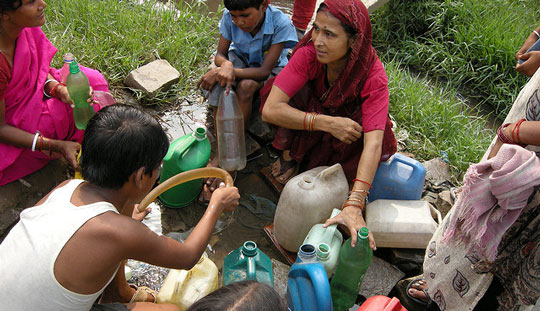
This project looked at water conflicts in areas on the edge of Delhi, to explore technological and environmental sustainability challenges in peri-urban areas. The project ran from 2006-2011.
Areas at the edge of cities are constantly changing and expanding. No longer solely seen in spatial terms, the peri-urban interface is increasingly recognised in terms of dynamic flows of commodities, capital, natural resources, people and pollution. Although often seen as a transition zone, peri-urban areas are expanding rather than diminishing.
A planning minefield
Peri-urban areas are framed in different ways by policy makers, academics, the powerful and powerless. There is a lack of understanding about the peri-urban environment, the diverse livelihoods of people experiencing different degrees of urbanization, and the perceptions and priorities of peri-urban villagers. As a result, planning decisions are almost inevitably flawed.
With no clear jurisdiction, ‘organised irresponsibility’ has emerged allowing powerful actors to benefit from the lack of regulation and constant impermanence.
Meanwhile the very marginalised and disenfranchised groups lack access to basic health, water and sanitation services. Often their rights to land, health and water are stripped away. Moreover, their livelihoods are frequently declared ‘illegal’ by the state and the judiciary.
Water and justice: peri-urban pathways in Delhi
A film illustrating the STEPS pathways approach through the voices of people with different experiences of water in peri-urban Delhi.
STEPS members involved in this project
- Fiona Marshall – Co-convenor
- Lyla Mehta – Co-convenor
- Hayley MacGregor – Research Fellow
- Pritpal Randhawa – Research Officer
- Linda Waldman – Research Fellow
STEPS partners on this project
- Awadhendra Sharan, Sarai, Centre for the Study of Developing Societies, New Delhi
- Professor Amitabh Kundu, Centre for the Study of Regional Development based at Jawarhalal Nehru University, New Delhi
Presentations
The following presentations were given at the STEPS Centre Symposium, September 2010.
- Water in the peri-urban: changing dynamics & critical Sustainability by Alankar
- Contesting Sustainability in the Peri-urban Interface: The Case of Water in Ghaziabad by Pritpal Randhawa
- Reframing the narrative: The land and water nexus in the periurban interface by Vishal Narain
Related links
- 4 May 2012: Edge of sustainability: why Rio+20 mustn’t ignore people on city fringe, The Guardian, write Fiona Marshall and Lyla Metha on Poverty Matters, the blog of the Guardian’s Global Development site.
- World Water Week: Sanitation Scandal
- Water: the ethics of efficiency Lyla Mehta writes about whether our food is too thirsty for Food Ethics magazine (pdf 2MB)
- Peri-urban dynamics and sustainability challenges – STEPS panel session at DSA Conference 2007
- Suman Sahai speaks at the STEPS Symposium
- STEPS Centre Symposium panels at the DSA Conference